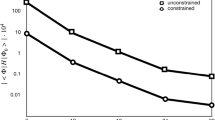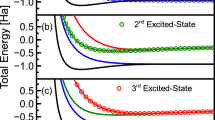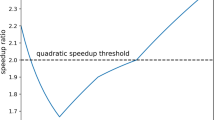Abstract
Approximating ground and a fixed number of excited state energies, or equivalently low-order Hamiltonian eigenvalues, is an important but computationally hard problem. Typically, the cost of classical deterministic algorithms grows exponentially with the number of degrees of freedom. Under general conditions, and using a perturbation approach, we provide a quantum algorithm that produces estimates of a constant number \(j\) of different low-order eigenvalues. The algorithm relies on a set of trial eigenvectors, whose construction depends on the particular Hamiltonian properties. We illustrate our results by considering a special case of the time-independent Schrödinger equation with \(d\) degrees of freedom. Our algorithm computes estimates of a constant number \(j\) of different low-order eigenvalues with error \(O(\varepsilon )\) and success probability at least \(\frac{3}{4}\), with cost polynomial in \(\frac{1}{\varepsilon }\) and \(d\). This extends our earlier results on algorithms for estimating the ground state energy. The technique we present is sufficiently general to apply to problems beyond the application studied in this paper.

Similar content being viewed by others
Notes
For functions \(f,g\ge 0\) defined on \({\mathbb R}_+\), the notation \(f(\varepsilon )=\omega (g(\varepsilon ))\) means that for any \(M>0\), arbitrarily large, we have \(f(\varepsilon )\ge M g(\varepsilon )\) for sufficiently small \(\varepsilon \).
We give an explicit construction for \(B\) in Eq. (17).
Here and elsewhere, by reasonable overlap we mean that the magnitude of the projection is not exponentially small in \(d\).
This follows immediately for \(m=O(1)\) from the bound \(\left( {\begin{array}{c}d\\ m\end{array}}\right) \le \frac{d^m}{m!} = poly(d)\).
References
Abrams, D.S., Lloyd, S.: Quantum algorithm providing exponential speed increase for finding eigenvalues and eigenvectors. Phys. Rev. Lett. 83, 5162–5165 (1999)
Aharonov, D., Ta-Shma, A.: Adiabatic quantum state generation and statistical zero knowledge. In: Proceedings of the Thirty-Fifth Annual ACM Symposium on Theory of Computing, pp. 20–29. ACM (2003)
Andrews, B., Clutterbuck, J.: Proof of the fundamental gap conjecture. J. Am. Math. Soc. 24(3), 899–916 (2011)
Aspuru-Guzik, A., Dutoi, A.D., Love, P.J., Head-Gordon, M.: Simulated quantum computation of molecular energies. Science 309(5741), 1704–1707 (2005)
Babuska, I., Osborn, J.: Eigenvalue problems. Handb. Numer. Anal. 2, 641 (1991)
Berry, D.W., Ahokas, G., Cleve, R., Sanders, B.C.: Efficient quantum algorithms for simulating sparse hamiltonians. Commun. Math. Phys. 270(2), 359–371 (2007)
Bravyi, S., Divincenzo, D.P., Oliveira, R.I., Terhal, B.M.: The complexity of stoquastic local Hamiltonian problems. Quantum Inf. Comput. 8(5), 361–385 (2008)
Cao, Y., Papageorgiou, A., Petras, I., Traub, J.F., Kais, S.: Quantum algorithm and circuit design solving the Poisson equation. New J. Phys. 15, 013021 (2013)
Childs, A.M., Gosset, D., Webb, Z.: The Bose–Hubbard model is qma-complete. In: Esparza, J., Fraigniaud, P., Husfeldt, T., Koutsoupias, E. (eds.) Automata, Languages, and Programming. Volume 8572 of Lecture Notes in Computer Science, pp. 308–319. Springer, Berlin (2014)
Cullum, J.K., Willoughby, R.A.: Lanczos algorithms for large symmetric eigenvalue computations: vol. 1: theory, vol. 41. SIAM (2002)
Demmel, J.W.: Applied Numerical Linear Algebra. SIAM, Philadelphia, PA (1997)
Feynman, R.: Simulating physics with computers. SIAM J. Comput. 26, 1484–1509 (1982)
Forsythe, G.E., Wasow, W.R.: Finite-Difference Methods for Partial Differential Equations. Dover, New York (2004)
Furche, F., Rappoport, D.: Density functional methods for excited states: equilibrium structure and electronic spectra. In: Olivucci, M. (ed.) Computational Photochemistry. Theoretical and Computational Chemistry, vol. 16, pp. 93–128. Elsevier, Amsterdam (2005)
Golub, G.H., Van Loan, C.F.: Matrix Computations. JHU Press, Baltimore (2012)
Gustafson, S.J., Sigal, I.M.: Mathematical Concepts of Quantum Mechanics. Springer, Berlin (2011)
Hislop, P.D., Sigal, I.M.: Introduction to Spectral Theory: With Applications to Schrödinger Operators. Number v. 113 in Applied Mathematical Sciences Series. Springer, New York (1996)
Hohenberg, P., Kohn, W.: Inhomogeneous electron gas. Phys. Rev. 136(3B), B864 (1964)
Kassal, I., Whitfield, J.D., Perdomo-Ortiz, A., Yung, M.-H., Aspuru-Guzik, A.: Simulating chemistry using quantum computers. Ann. Rev. Phys. Chem. 62, 185–207 (2011)
Kempe, J., Kitaev, A., Regev, O.: The complexity of the local Hamiltonian problem. SIAM J. Comput. 35(5), 1070–1097 (2006)
Klappenecker, A., Rötteler, M.: Discrete cosine transforms on quantum computers. In: Proceedings of the 2nd International Symposium on Image and Signal Processing and Analysis, pp. 464–468 (2001)
Lanyon, B.P., Whitfield, J.D., Gillett, G.G., Goggin, M.E., Almeida, M.P., Kassal, I., Biamonte, J.D., Mohseni, M., Powell, B.J., Barbieri, M., Aspuru-Guzik, A., White, A.G.: Towards quantum chemistry on a quantum computer. Nat. Chem. 2, 106–111 (2010)
Leveque, R.J.: Finite Difference Methods for Ordinary and Partial Differential Equations. SIAM, Philadelphia, PA (2007)
Lloyd, S.: Universal quantum simulators. Science 273(5278), 1073–1078 (1996)
Love, P.J.: Back to the future: a roadmap for quantum simulation from vintage quantum chemistry. In: Kais, S. (ed.) Quantum Information and Computation for Chemistry. Advances in Chemical Physics, vol. 154, pp. 39–66. Wiley, Hoboken, NJ (2014)
Nielsen, M., Chuang, I.: Quantum Computation and Quantum Information. Cambridge University Press, Cambridge (2000)
Papageorgiou, A.: On the complexity of the multivariate Sturm–Liouville eigenvalue problem. J. Complex. 23(4–6), 802–827 (2007)
Papageorgiou, A., Petras, I.: Estimating the ground state energy of the Schrödinger equation for convex potentials. J. Complex. 30, 469–494 (2014)
Papageorgiou, A., Petras, I., Traub, J.F., Zhang, C.: A fast algorithm for approximating the ground state energy on a quantum computer. Math. Comput. 82(284), 2293–2304 (2014)
Papageorgiou, A., Traub, J.F.: Measures of quantum computing speedup. Phys. Rev. A 88(2), 022316 (2013)
Papageorgiou, A., Zhang, C.: On the efficiency of quantum algorithms for Hamiltonian simulation. Quantum Inf. Process. 11, 541–561 (2012)
Parlett, B.N.: The Symmetric Eigenvalue Problem, vol. 7. SIAM, Philadelphia (1980)
Schuch, N., Verstraete, F.: Computational complexity of interacting electrons and fundamental limitations of density functional theory. Nat. Phys. 5(10), 732–735 (2009)
Strang, G., Fix, G.J.: An Analysis of the Finite Element Method, 2nd edn. Wellesley-Cambridge Press, Wellesley (2008)
Suzuki, M.: Fractal decomposition of exponential operators with applications to many-body theories and Monte Carlo simulations. Phys. Lett. A 146(6), 319–323 (1990)
Suzuki, M.: General theory of fractal path integrals with application to many-body theories and statistical physics. J. Math. Phys. 32, 400–407 (1991)
Titchmarsh, E.C.: Eigenfunction Expansions: Associated with Second-Order Differential Equations. Oxford University Press, Oxford (1962)
Wei, T.-C., Mosca, M., Nayak, A.: Interacting boson problems can be QMA hard. Phys. Rev. Lett. 104(4), 040501 (2010)
Weinberger, H.F.: Upper and lower bounds for eigenvalues by finite difference methods. Commun. Pure Appl. Math. 9(3), 613–623 (1956)
Weinberger, H.F.: Lower bounds for higher eigenvalues by finite difference methods. Pac. J. Math. 8(2), 339–368 (1958)
Wickerhauser, M.V.: Adapted Wavelet Analysis from Theory to Software. A.K. Peters, Wellesley, MA (1994)
Zalka, C.: Efficient simulation of quantum systems by quantum computers. Fortschr. Phys. 46(6–8), 877–879 (1998)
Zalka, C.: Simulating quantum systems on a quantum computer. Proc. R. Soc. Lond. Ser. A Math. Phys. Eng. Sci. 454(1969), 313–322 (1998)
Acknowledgments
The authors would like to thank Joseph F. Traub for useful comments and suggestions. This research has been supported in part by NSF/DMS.
Author information
Authors and Affiliations
Corresponding author
Rights and permissions
About this article
Cite this article
Hadfield, S., Papageorgiou, A. Approximating ground and excited state energies on a quantum computer. Quantum Inf Process 14, 1151–1178 (2015). https://doi.org/10.1007/s11128-015-0927-y
Received:
Accepted:
Published:
Issue Date:
DOI: https://doi.org/10.1007/s11128-015-0927-y




